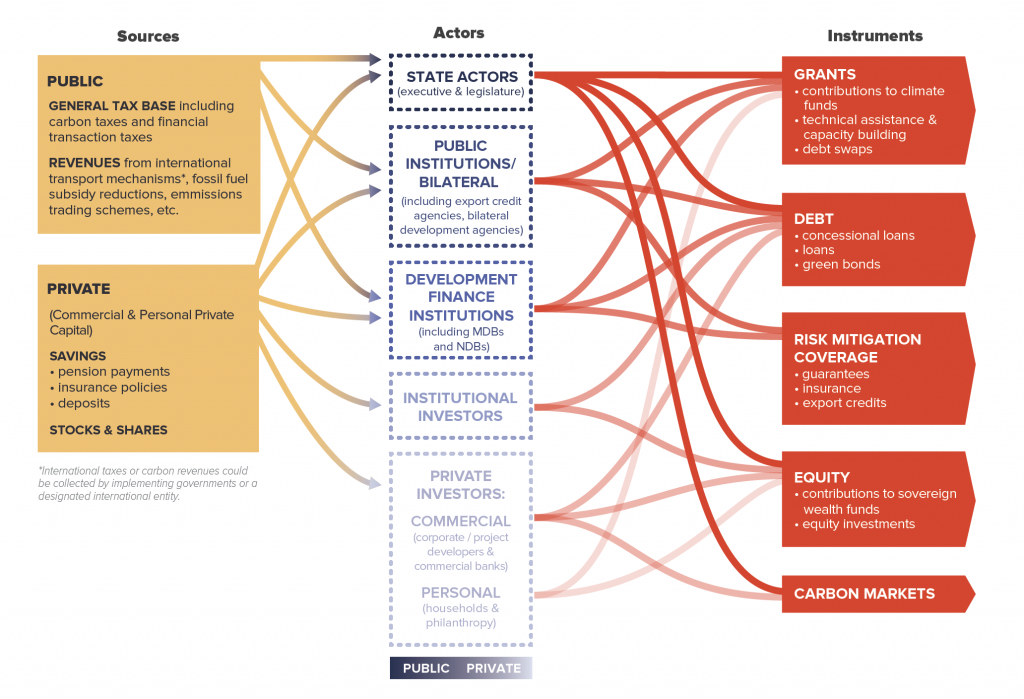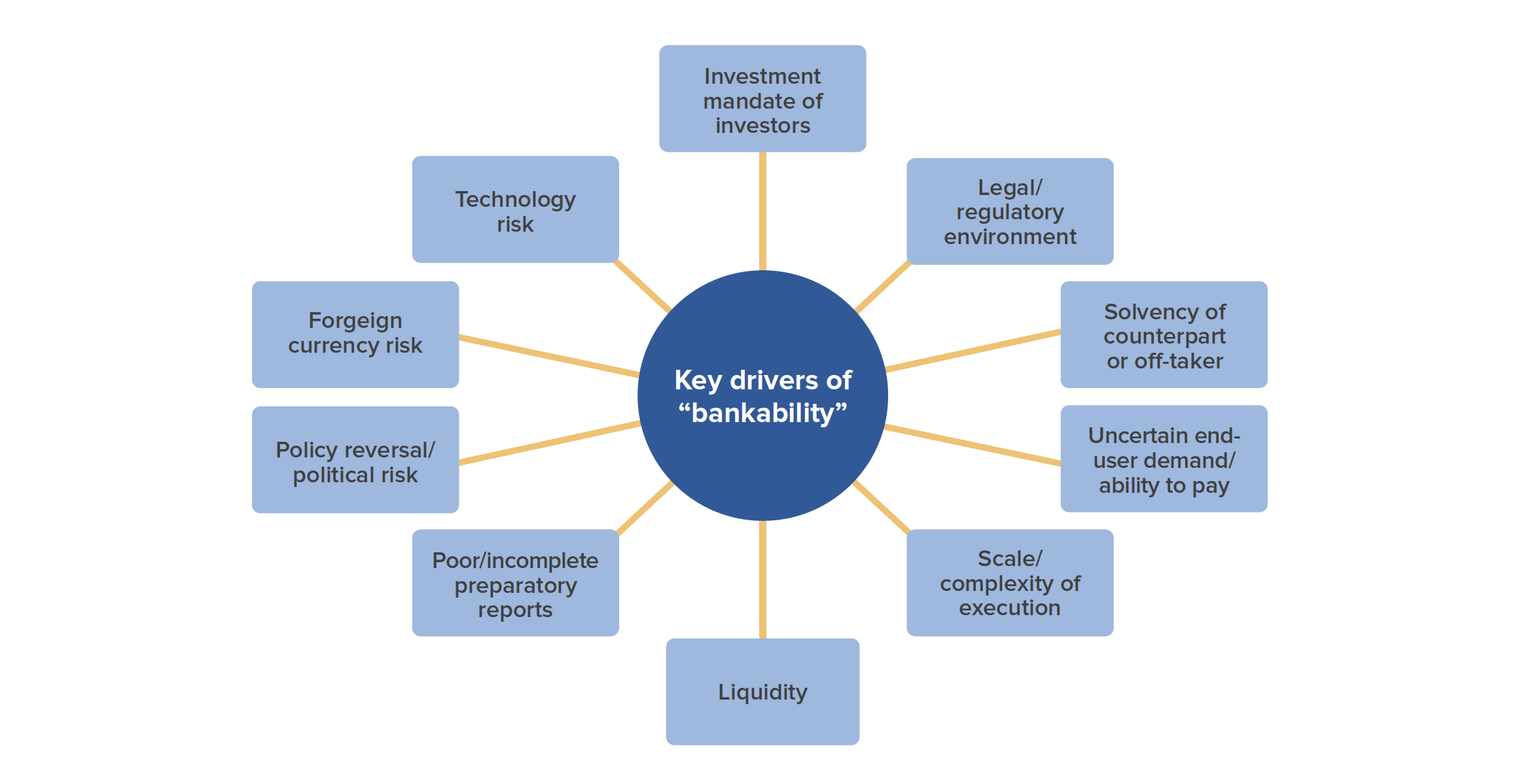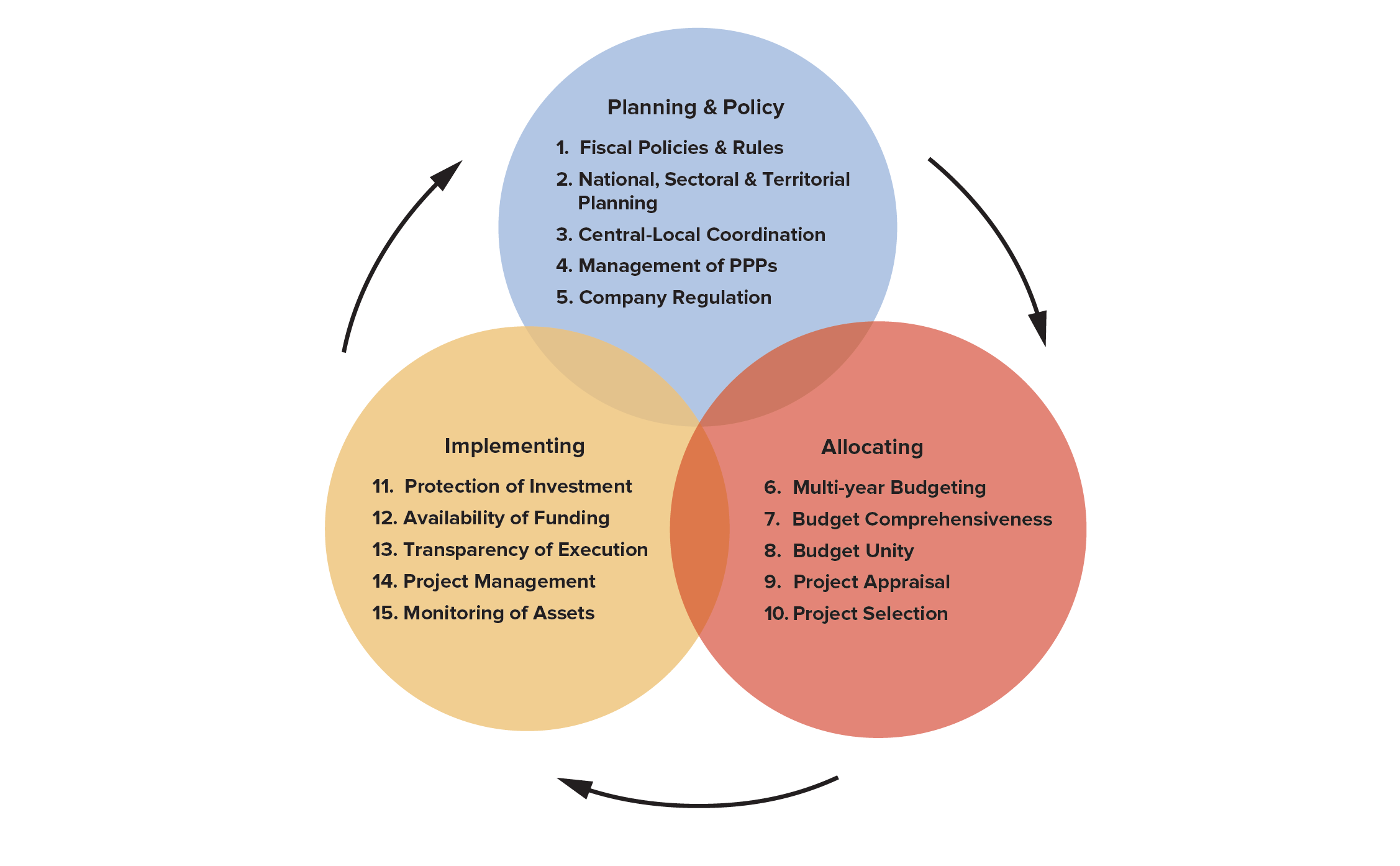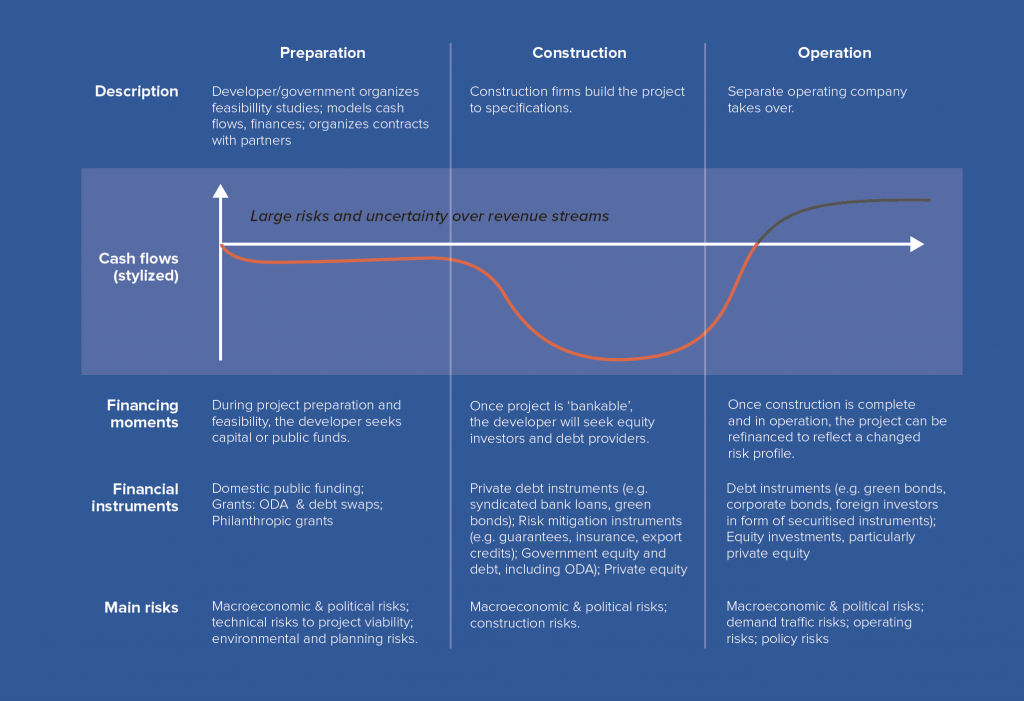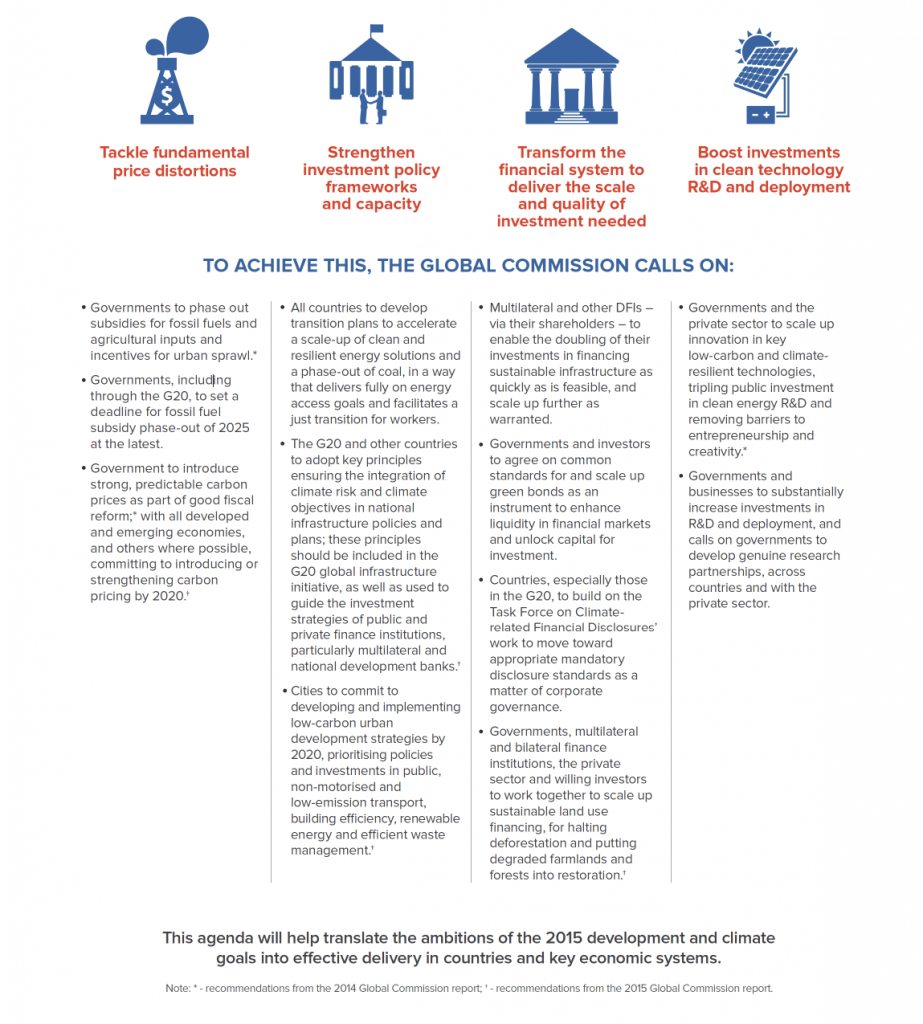We have identified four areas where concerted action can help overcome these barriers and boost investments in sustainable infrastructure. They are:
- We must collectively tackle fundamental price distortions – including subsidies and lack of appropriate pricing especially for fossil fuels and carbon– to improve incentives for investment and innovation, and to generate revenue that can be redirected, for instance, to support the poor.
- We must strengthen policy frameworks and institutional capacities to deliver the right policies and enabling conditions for investment, to build pipelines of viable and sustainable projects, to reduce high development and transaction costs, and to attract private investment.
- We must transform the financial system to deliver the scale and quality of investment needed in order to augment financing from all sources (especially private sources such as long-term debt finance and the large pools of institutional investor capital), reduce the cost of capital, enable catalytic finance from development finance institutions (DFIs), and accelerate the greening of the financial system.
- We must ramp up investments in clean technology R&D and deployment to reduce the costs and enhance the accessibility of more sustainable technologies.
We provide an overview of each area here. Section 3 of the report delves deeper into action area 3 as a cross-cutting area, and then the final three sections apply the other remaining action areas to the specific contexts of energy, cities and land use.
Tackle the fundamental price distortions
Correcting the pervasive and significant distortions in the pricing of climate risk, natural resource use and environmental harm is a key first step to creating an enabling policy environment for sustainable infrastructure. Those distortions – including the failure to price carbon or pollution, as well as a range of subsidies – strongly bias infrastructure investment towards fossil fuels and against cleaner energy technologies, encourage inefficient use of natural resources and wasteful consumption, and cause serious environmental impacts.
Globally, fossil fuel subsidies and tax breaks amounted to approximately US$550 billion in 2014.33 This reflects a reduction from previous years, partly due to continuing low oil prices but also partly as a result of significant reforms that are underway or have been launched in various countries.34 There is also growing momentum around pricing carbon. Around 40 countries and more than 20 cities, states and regions, including 7 of the top 10 economies, have implemented or scheduled an explicit price on carbon. Together they cover an estimated 7 Gt CO2e, or about 13% of annual GHG emissions – triple the coverage of a decade ago.35 In addition, more than 90 countries refer to some form of carbon pricing in their Paris Agreement pledges.
A concerted push can translate this momentum into decisive action and overcome political and economic barriers. The Commission welcomes the coalitions that are being built to tackle these issues (e.g. through the G20 or the Carbon Pricing Leadership Coalition), which can accelerate progress, provide political leadership, foster mutual learning, and help improve practices by developing guidance on technical, administrative, political and economic cooperation aspects of carbon pricing (see Section 4 – Energy).36
Pricing reform should not, of course, be limited to the energy sector. Water subsidies, for instance, which are estimated at around US$450 billion globally, or 0.6% of global GDP in 2012, encourage inefficient and unsustainable resource use and strain public budgets.37 Like energy subsidies, they are also often inequitable; for example, in India, Nepal, Nicaragua, and Cape Verde, the richest households got an average of US$3 worth of subsidised water for every US$1 worth provided to the poorest households.38 Governments need to review prices across sectors to align them better with economic fundamentals, including externalities, and use more targeted measures to help the poor.
More broadly, pricing of infrastructure services should reflect the full costs of their provision, including where possible the social and environmental externalities. Lack of proper user charges for built infrastructure is a major impediment to attracting private investment, as private investors and operators require predictable and robust revenue streams to recover their costs. For public-managed infrastructure, lack of appropriate pricing limits the availability of funds for other uses, such as extending access to essential energy, water and sanitation services to those without, or properly maintaining the existing infrastructure. Overall, poor pricing leads to reduced service provision and quality. This can turn into a vicious circle, whereby infrastructure users are dissatisfied with the services, and thus reluctant to pay for them. For energy and urban systems, pricing is essential to reflect the social costs of externalities, for example the costs of air pollution from fossil fuel use as well as of congestion from urban vehicle use. For natural infrastructure and ecosystem services, pricing to reflect the value of these services can ensure efficient use, for instance, reducing wasteful use of water or access to timber, and help secure finances to invest in restoration or maintenance of the ecosystems.
Strengthen policy frameworks and institutional capacities
Establishing a well-defined and appropriately evaluated pipeline of projects means tackling major underlying policy problems, such as an absence of national strategies, weak legal frameworks to protect investments, promote competition and trade, poor planning, inadequate PPP frameworks and implementation, and skill shortages. There is also a need to better define what makes a bankable project; many infrastructure projects have high public-goods components that may never be considered viable using only financial assessment techniques designed to assess bankability from a private sector perspective. Overall the enabling policy environment in a country will determine the level of engagement from the private sector, but even in the best circumstances public investments will be essential to deliver sustainable infrastructure systems.
Given that a large share of the investment for sustainable infrastructure, especially in developing countries, is likely to come from the public sector, there is value in “investing in investment” –strengthening public investment management to drive growth and environmental performance. As noted earlier, in advanced economies, investing an extra 1% of GDP in infrastructure in a single year will yield, on average, a 1.5% gain over four years.39 While the multiplier effect is smaller for developing countries, the sustainability impact of new infrastructure in places with large deficits can be enormous.
Improving the efficiency and performance of public investments should involve planning for sustainable levels of investment across the public sector, allocating investments to the right sectors and projects, and implementing projects on time and to budget. Unpacked further, a number of institutional and efficiency improvements can contribute to overall performance in public operations while also helping to attract private investment where relevant (see Figure 7). Key outcomes would be not just more efficiency in public investment, but also establishing the enabling conditions and a framework for private investment to lead in some spheres (e.g. in the energy sector).
 The Sustainable Infrastructure Imperative
The Sustainable Infrastructure Imperative